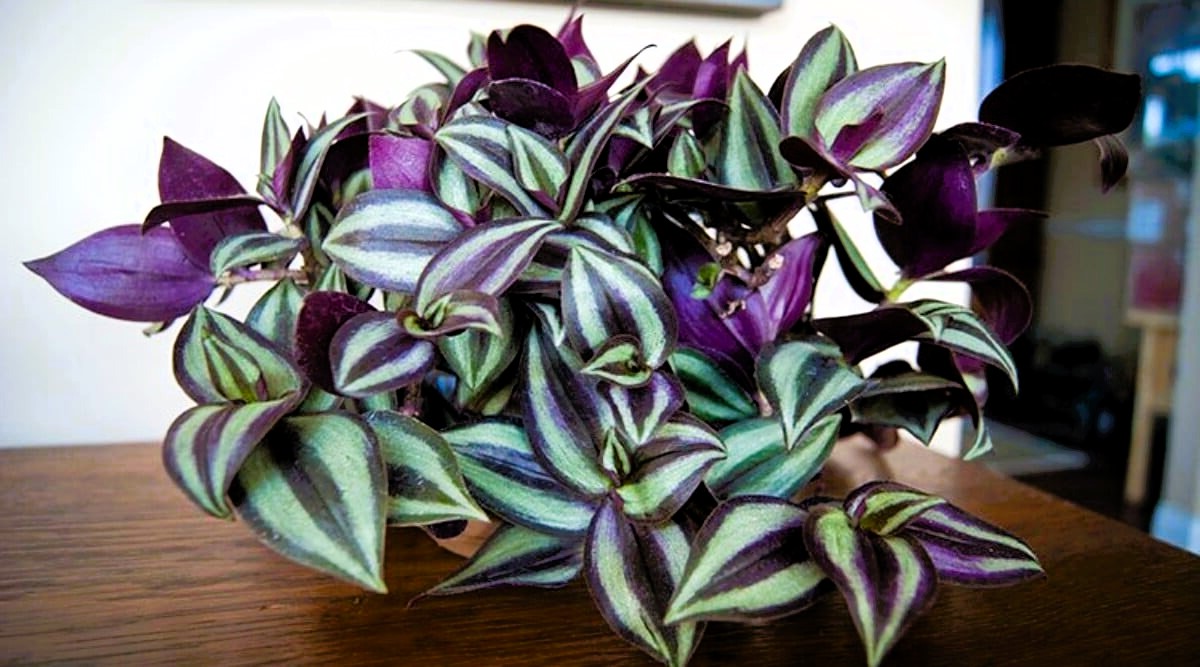The wandering jew plant, known scientifically as Tradescantia, is a striking addition to indoor and outdoor spaces, celebrated for its vibrant foliage and trailing habit. This plant thrives with basic care and offers a lush, textured look to any area it occupies. Caring for it, however, can be nuanced due to its specific light, water, and environmental needs. This guide will walk you through the essentials of maintaining a healthy wandering jew plant care , providing you with all you need to know to keep it growing and glowing.
Understanding the Basics of Wandering Jew Plant Care
Light Requirements
The wandering jew plant loves bright, indirect sunlight. Its leaves display their best colors when exposed to consistent, filtered light. Placing it near a sunny window works well, as long as the light isn’t too direct. Direct sunlight can cause the foliage to scorch or fade, while too little light will make the colors dull and the plant leggy.
For the best color and compact growth:
- Indoors: Position the plant where it will receive indirect sunlight, like near a north or east-facing window.
- Outdoors: If growing outdoors, aim to place it in a shaded or semi-shaded location, avoiding harsh midday sun.
When growing this plant indoors, artificial lighting can also work if natural light is limited. A grow light can provide the necessary spectrum to keep your wandering jew vibrant.
Watering Routine
The wandering jew plant enjoys consistent moisture, but overwatering can quickly lead to root rot. Striking the right balance with water is essential.
Here’s how to create a good watering schedule:
- Soil Moisture: Water when the top inch of soil feels dry. Insert your finger into the soil to check – if it’s dry to the touch, it’s time to water.
- Watering Frequency: Typically, watering once a week suffices, but this varies based on your plant’s location and the season. Indoor plants generally need less water in the winter months when they’re in a semi-dormant phase.
- Drainage: Make sure the pot has good drainage. Sitting in excess water is one of the quickest ways to harm your plant. Empty the saucer after watering to avoid prolonged contact with water.
To keep your plant hydrated and prevent root rot, focus on consistent, moderate watering without drenching the soil. Using a spray bottle to mist the leaves can also be beneficial, especially in dry climates, but don’t rely on misting as a substitute for regular watering.
Temperature and Humidity Needs
The care of wandering jew plant prefers warmer temperatures and moderate humidity levels. Since it’s a tropical plant, replicating its native environment with warmth and humidity is ideal.
Optimal conditions include:
- Temperature: Aim for temperatures between 60°F and 80°F (16°C – 27°C). Avoid exposing the plant to temperatures below 50°F (10°C), as cold drafts can damage it.
- Humidity: Higher humidity enhances its growth. If your home is dry, especially in winter, consider placing a small humidifier nearby or setting the pot on a tray of water and pebbles. Avoid misting directly onto the foliage in very cold or overly hot conditions, as this could lead to leaf issues.
Choosing the Right Soil and Fertilizer
Soil Mix
A well-draining, nutrient-rich soil mix is essential for the wandering jew plant. An all-purpose potting soil mixed with perlite or sand is ideal. This mix promotes aeration and prevents the soil from becoming too compact.
- Soil Properties: It should retain some moisture without staying soggy. The perlite or sand helps improve drainage, making it easier to avoid waterlogged roots.
- Repotting: Every 1–2 years, consider repotting your wandering jew plant to refresh the soil and provide more space for root growth. Choose a pot one size larger than the current one to allow for expansion, but avoid going too big, as this can retain excess moisture.
Fertilizing Tips
Regular feeding can enhance the color and growth rate of your plant. Here’s what works best:
- Type of Fertilizer: A balanced, water-soluble fertilizer is ideal for the wandering jew. Look for one with equal parts nitrogen, phosphorus, and potassium (like a 10-10-10 formula).
- Frequency: Fertilize every 4–6 weeks during the growing season (spring and summer). Reduce or stop fertilizing in the fall and winter, when the plant’s growth naturally slows.
- Application: Dilute the fertilizer to half the recommended strength. Wandering jew plants are relatively sensitive to strong fertilizers, so a mild dose is better.
Avoid over-fertilizing, as too many nutrients can cause the foliage to become scorched or lead to a build-up of salts in the soil, which can impact root health.
Pruning and Propagation for a Healthier Plant
Pruning not only keeps your wandering jew plant looking its best but also encourages bushier growth. As the plant matures, it may become leggy or sparse, especially if it isn’t receiving enough light.
Steps for effective pruning:
- Trim Regularly: Cut back long, trailing stems to encourage branching. This will lead to a fuller appearance.
- Remove Dead or Dying Leaves: Regularly removing any dead or yellowing leaves prevents energy from being diverted to damaged areas, promoting healthier overall growth.
- Pinch the Tips: Pinching the tips of each vine encourages the plant to grow outward rather than elongate.
Propagation for Expansion
One of the most satisfying parts of caring for a wandering jew plant is its ease of propagation. You can use cuttings from your existing plant to grow new plants in water or soil.
Here’s how to propagate effectively:
- Select a Stem: Choose a healthy stem with at least a few leaves. Cut just below a node (the spot where leaves emerge).
- Water Propagation: Place the cutting in a glass of water, ensuring the node is submerged. Roots should start forming in 1–2 weeks, at which point you can transfer it to soil.
- Soil Propagation: Insert the cutting directly into a small pot filled with moist soil. Keep the soil slightly moist and in a warm spot. Roots should establish within a few weeks.
Propagation is an excellent way to expand your collection, fill out sparse pots, or share plants with friends. It’s a straightforward process that adds a lot of value to your plant-care routine.
Common Issues and Solutions
Pests to Watch For
While relatively resilient, the wandering jew plant is occasionally susceptible to pests like spider mites, aphids, and mealybugs. These pests can cause leaf damage, discoloration, and reduced vigor in the plant.
To handle pests:
- Spider Mites: These tiny pests create webbing on leaves and can make them look dusty. Treat by washing the plant with a gentle soap and water mix or using neem oil as a preventive measure.
- Aphids: Aphids cluster on new growth and feed on plant sap. Spray them off with water or use insecticidal soap as needed.
- Mealybugs: These pests leave behind a cotton-like residue. Remove them with a cotton swab dipped in alcohol and wipe the leaves to discourage reinfestation.
Regularly inspecting your plant for pests helps prevent infestations from escalating. Keeping the leaves clean and providing good air circulation around the plant also minimizes pest risks.
Dealing with Browning or Yellowing Leaves
It’s common for wandering jew plants to develop browning or yellowing leaves, often due to issues with water or humidity. Here’s a quick troubleshooting guide:
- Yellow Leaves: Typically a sign of overwatering or poor drainage. Check that the soil isn’t staying overly wet and that your pot drains well.
- Brown Tips: This can indicate underwatering or low humidity. Increase watering slightly, or boost humidity around the plant.
- Leggy Growth: If your plant is growing long and spindly, it may need more light. Move it to a spot with brighter, indirect light.
Monitoring your plant regularly for these signs allows you to make small adjustments before issues worsen. With small tweaks to water, light, and humidity, most of these problems can be easily corrected.
Seasonal Care Tips
Spring and Summer
During the growing season, wandering jew plant care are most active and may need more frequent watering and feeding. Trim back any leggy growth early in spring to encourage fuller growth through summer.
- Watering: Increase frequency slightly, keeping soil consistently moist.
- Fertilizing: Feed every 4–6 weeks with diluted fertilizer.
Fall and Winter
As the weather cools, your wandering jew plant will slow down, requiring less water and no additional fertilizer. Reduce watering and allow the top layer of soil to dry out more thoroughly between waterings.
- Avoid Repotting: Wait until spring for any major repotting or propagation, as these processes can stress the plant during colder months.
Bringing It All Together How to Care wandering jew plant
Caring for a wandering jew plant is all about creating balance. With the right amount of light, water, and a few periodic trims, this resilient plant will thrive and bring vibrant beauty to your home. Embrace its natural growth habits, propagate it for new plants, and enjoy the satisfaction of a lush, healthy plant that adds life and texture to your space. Whether indoors or outdoors, the wandering jew plant offers a rewarding experience for plant lovers, from beginners to seasoned gardeners alike.
Check video guide How to Care wandering jew plant

